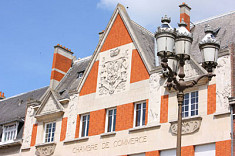Contents
The project to rebuild and refurbish Cambrai was put together by a commission comprising architects, engineers, business people, elected representatives and artists. The architect Pierre Leprince-Ringuet was given the task of coordinating the works although other architects were brought in for specific jobs.
The town centre had been demolished and burned to the ground in the war and this was seen as an opportunity to start afresh. The focal point of the new layout would be the town hall with the other key institutions of the town––the court, the chamber of commerce, the post office and the tax office––located on a new square behind the main square. The commercial district of the town would be centred on Place d'Armes and in the adjacent streets.
To avoid congestion in the town centre a new street layout was drawn up. It was based on two main arteries which would cross the main square from north to south and east to west. New streets were built and the old narrow streets were widened and rectified. A grid layout was not adopted, which would have changed the character of the town, however the street network was given a straighter perspective. Avenue de la Victoire and mail Saint-Martin were built to provide more space around the town hall and the train station. New suburbs on the space formerly occupied by the ramparts were built alongside a ring road and bridges were added.
The new constructions in the centre were similar to the originals but slightly modified to improve their architectural beauty. For example, the town hall was built in the style of the 18th century and the houses on place d'Armes, in the Flemish style.
The reconstruction was also an opportunity for improving public health. Abattoirs were moved out to the periphery of the town and a sewage treatment works and an incinerator for burning household waste were also built.
The planning process required the compulsory purchase of a number of sites, which was a prerogative of the French State. In 1922 a convention known as "Garin's Law" or "Cambrai's Law" was signed by the Mayor of Cambrai, Edmond Garin and a state representative to allow the town council to proceed with compulsory purchasing in place of the state. These legal problems delayed the reconstruction of Cambrai which eventually started in 1923 and was finally completed in 1932 with the official opening of the town hall.
Claudine WALLART,
Head Curator of Heritage
at the Archives Départementales du Nord
(Nord Records Office)
Archive pictures

coll. particulière (jpg - 0.08 MB)




